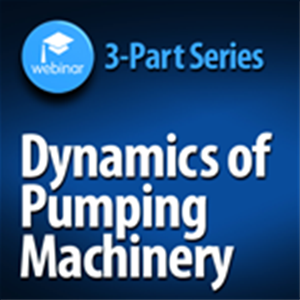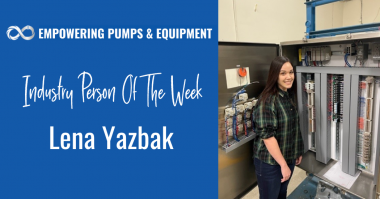For the majority of pump applications, the growing use of variable speed operation has increased the likelihood of resonance conditions that can cause excessive vibration levels, which can negatively impact pump performance and reliability. To avoid vibration issues, potential complications must be properly addressed and mitigated during the design phase.
While most mass-produced rotodynamic pumps don’t require additional engineering as manufacturers have completed appropriate validations during the design and development process, new pump designs require additional analysis associated with resonance conditions. Other factors that merit further pump evaluation include:
- Existing equipment undergoing field modification and rerate
- Existing equipment identified with high vibration and reliability issues caused by resonance. Typically understood by a thorough field analysis.
- Non-standard pump applications, where the dynamics characteristics of pumping equipment may be significantly influenced by the installation
Proper evaluation of pumping machinery construction and relevant site characteristics can help determine the effects that resonance will have on product life and reliability. All aspects of the installation such as the discharge head, mounting structure, piping and drive system will affect lateral, torsional and structural frequencies of the pumping system. After installation, it is difficult and expensive to trouble shoot and modify these components to attain desirable dynamic characteristics. Therefore, it is best to conduct the analysis during the initial design phase to reduce the probability of reliability problems and the time and expense associated.
Types of Dynamic Analyses
Three main types of dynamic analyses can be conducted on pumps and pump trains: lateral, torsional and structural. In evaluating different aspects of pumping machinery, these analytical tools help to avoid resonance and vibration issues to improve pump product life and reliability. Each category utilizes its own analysis methodology and corrective action.
The need for any particular analysis and the level of its detail depends on the pump type, application, potential costs associated with equipment start-up problems and other factors. Evaluations may include drive systems, ancillary equipment and the effects of local foundation and piping systems.
Structural Analysis
Structural analysis of pump machinery provides reasonable assurance that structural natural frequencies will not cause significant amplification of excitation frequencies. This analysis should be performed on the relevant non-rotating portions of the pump and attached components that add significant mass and/or stiffness.The final analysis should provide a tabulation of the natural frequencies and mode shapes within the range of excitation frequencies.
Lateral Analysis
Concerned with the rotor part of the pump, the lateral analysis is performed to assess the potential for high vibration, associated degradation, and eventual equipment failure after pump installation. A key deliverable is a Campbell diagram that pictorially identifies which natural frequencies are closest to excitation frequencies.
Torsional Analysis
Excessive torsional vibration can contribute to coupling damage, gear wear or tooth failure, shaft failure and loosening of motor windings. Performed on the complete pump train (pump, driver, couplings, gears, etc.), torsional analysis simulates how the pump, motor, coupling and gear operate dynamically in twist excitation when run together as a system and identifies the torsional natural frequencies (as opposed to natural frequencies that vibrate in the axial or lateral directions).
The analysis helps to determine if any significant vibration will result from a resonant frequency issue or if any torsional vibration might cause alternating stress at peak torsional deformation locations on the shaft, which is sufficient to cause high cycle or even low cycle fatigue. The key deliverable is a Campbell diagram, similar to that of the lateral analysis.
Simple to Complex Analysis
Different levels of detailed evaluation and validation may be required from the analysis, based on the degree of equipment uncertainty and application risk.
Level 1 Analysis – includes simple calculations using standard equations that may be performed with a hand calculator. Level 1 calculations involve significant simplifying assumptions. For example, calculating the structural resonance in vertical pumps, where foundations and bolted joints are assumed to be infinitely stiff. A Level 1analysis may be adequate for small and simple equipment
Level 2 Analysis – implements intermediate methods involving basic mass elastic modeling executed with commercially-available software tools such as finite element analysis (FEA). The most predominantly used rotodynamic analysis, FEA programs offer a large choice of element types, allowing users to select the appropriate elements for the structure under investigation and its particular application.
Intermediate analysis includes more elements than a level 1 analysis such as:
- Radial and axial hydraulic loads
- Annular seal dynamic coefficient, impeller-casing interaction, and static and dynamic sleeve bearing coefficients
Level 2 intermediate levelanalysis provides adequate levels of accuracy to prove most cases.
Level 3 Analysis – implements advanced methods and more complex structural analyses, using both FEA programs and specialized rotodynamic programs. A level 3 analysis can include one or more of the following elements:
- Damped lateral rotordynamic analyses of vertical pumps
- The influence of the structure considered by means of a combined structure-rotor analysis or by considering the dynamic bearing support stiffness coefficients calculated in a preceding structural harmonic response analysis
- Radial and axial hydraulic loads together with loads due to mechanical/hydraulic imbalance
- The worst combination of these loads as determined by a sensitivity/parameter study
- Annular seal dynamic coefficients, impeller-casing interaction coefficients, and static and dynamic sleeve bearing coefficients
By providing an increased level of accuracy, Level 3 analysis provides for a greater degree of mitigation of the given risk and uncertainty.
In summary, the purpose of performing any degree of dynamic analysis is to provide some appropriate level of validation prior to the manufacture or installation of the pump package, into its intended operating environment. Proper analysis during the design phase can help avoid problems associated with excessive vibration that can lead to failure.
To learn more about the three types of dynamic analysis and understand which tools are appropriate for various applications, attend the Hydraulic Institute’s three part webinar series on Rotodynamic Pumps – Guidelines for Proper Lateral, Torsional and Structural Frequency Analyses of Pumping Machinery, which will be held on October 29, November 5th and November 12th.
For more information, contact Mark Sullivan, Director, Education & Marketing, Hydraulic Institute, at msullivan@Pumps.org or call him directly at 973-349-5329 you can also register at http://estore.pumps.org. The course covers a range of rotodynamic pumps, both new and currently installed within the field.





Comments